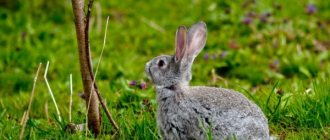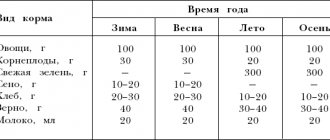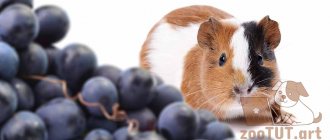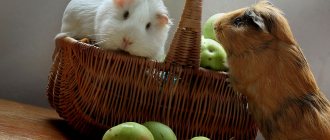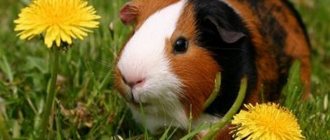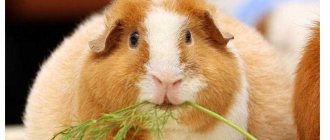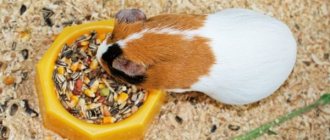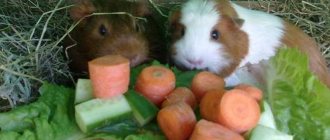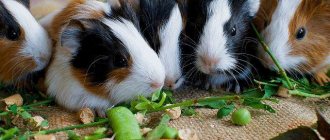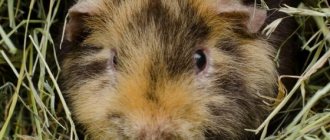Twigs
Twigs ¶
From: Svinni - April 12, 2007 0:17
Good evening! I read that pigs should be given twigs to chew on. And what branches can they use (which trees or bushes) Thanks in advance
Twigs ¶
Good evening! I read that pigs should be given twigs to chew on. And what branches can they use (which trees or bushes) Thanks in advance. Apple trees can definitely be used, probably plums and cherries, but I know for sure lilacs can’t. In any case, I gave exactly these and everything was fine.
Twigs ¶
There are a lot of topics on the forum about branches, but what to do with leaves? I read that apple, currant, raspberry, etc. branches are given with foliage. But what about willow, birch, I don’t mean fruit trees? Today I cut a bunch of branches, I’m sitting, thinking whether to pick off the leaves or leave them - this is our first spring, we have no experience in such things.
Twigs ¶
From: Galina - April 12, 2007 4:54 am
You can: birch, ash, maple, apple tree (dry the branches), alder, pear, willow (all types), rowan, linden. They can be given to the pig “for free use.”
Avoid: tree branches that have seeds in their fruit, i.e. apricot, peach, cherry, plum, etc. (because if they have not been dried for at least 6 months, they may contain cyanogen glucosides, which cause intoxication); branches of coniferous trees; citrus branches like orange, lemon, tangerine, etc. (contain limonin).
Twigs ¶
You can: birch, ash, maple, apple tree (dry the branches), alder, pear, willow (all types), rowan, linden. You can put them “for free use” by the pig. “For free use” does this mean both branches and leaves?
Article on the topic: What to feed a guinea pig at home: food and a list of foods that can and cannot be included in the diet
Twigs ¶
From: Galina - April 13, 2007 5:45 am
For free use - this means that the twigs (with or without leaves) can always be at the disposal of the pigs, they do not need to be limited. Here’s another example for you, a statement from the forum: My pigs get plenty of hard feed and their bite is fine. In the summer, I stocked up on apple branches with leaves (one of my favorite treats) as an additional diet; in addition to the leaves, she also eats branches, nibbles them off and eats them, chewing them thoroughly.
Twigs ¶
From: Svinni - April 13, 2007 2:45 pm
Can pigs have cherry branches and leaves? And I didn’t quite understand something, can I have imiren or not?
Twigs ¶
From: Galina - April 14, 2007 0:49
Can pigs have cherry branches and leaves? And I didn’t quite understand something, can I have imiren or not? I don't know anything about lilacs. The only thing I can say is that I have never seen a single animal that would eat it, and I have never even seen caterpillars on it. Cherry branches may contain the same substance as the fruits inside in the pits - albeit in smaller quantities, and it is toxic. That’s why it is recommended to dry cherry branches (and all fruit trees with seeds) for six months before giving them to the pig.
Twigs ¶
From: L_enok - April 14, 2007 2:50
And I gave my pigs and the little pig before them apple tree branches with leaves and birch. They tore down the birch tree with buds and whole twigs, and from the apple tree there was bark and young leaves at the entrance))) It seems to me that the animals themselves will not eat something harmful to them, although of course, the risk in this case is not justified and it is better not to try. Give only what is absolutely possible.
Article on the topic: Can guinea pigs eat avocado, pineapple, mango and kiwi?
Twigs ¶
From: Venus - April 14, 2007 2:29 pm
Do any branches need to be dried for six months?
Twigs ¶
From: Galina - April 14, 2007 5:53 pm
Do any branches need to be dried for six months? No, not any, but only branches of fruit trees whose fruits have pits (cherry, plum, etc.), as well as branches of an apple tree, it is recommended to dry them first.
Twigs ¶
From: Sana - April 14, 2007 6:53 pm
I only give birch and willow twigs (the only ones I can pick when we go to the pond, nothing else “edible” grows there). They go out with a bang! Just be sure to wash and dry!
Twigs ¶
Excuse me, but for example, dry apple tree branches with the leaves? Or can you tear off the leaves and give them fresh and dry the branches?
Twigs ¶
From: Galina - April 15, 2007 4:47 pm
Excuse me, but for example, dry apple tree branches with the leaves? Or can you tear off the leaves and give them fresh and dry the branches? You'll kill me, girls. At first we disassembled each twig separately, and now we will disassemble the leaves. I’m not a botanist, but I know for sure that there are no filters in tree branches, so the sap through the plant should flow the same everywhere, as it seems to me. Therefore, I would dry everything - both the branch and the leaves. In the summer, I advise you to prepare branches with alder cones (the cones are small, black, also sold in pharmacies) - just in case, they are a very good remedy for diarrhea, a decoction of them is even used for infants with diarrhea, and you can let the pig chew the cones or brew them. Alder is edible for pigs.
What to feed your guinea pig?
Guinea pigs are one of the most popular pets. Caring for them is quite easy, and even a schoolchild can cope with this task.
The pigs' cage is cleaned 1-2 times a week, and compressed sawdust, wood shavings or cat litter are poured onto the floor.
What should you feed your guinea pig so that it lives out its life healthy, playful and happy?
The main food of guinea pigs is hay . It must be in the cage at all times. Hay normalizes the functioning of the animal’s gastrointestinal tract. Together with the hard grain , it helps the pig wear down its teeth. Guinea pigs are rodents; their teeth grow throughout their lives. If the incisors are not allowed to wear down, they grow so large that they prevent the animal from closing its mouth and chewing, which can lead to illness and death of the pig.
You can buy hay at the store or make it yourself. If the hay has darkened, acquired an unpleasant odor or become damp, then you should not feed it to animals. It is better to throw away such hay and not even use it as bedding: after all, the pig can eat it and get poisoned.
Photo: pixabay.com
Pigs can be fed many types of herbs : dandelion, plantain, clover, nettle, alfalfa, chamomile, yarrow, knotweed (popularly known as knotweed), spinach, meadow chin, sweet clover, mouse pea, mantle, meadowsweet, mallow, fireweed, tansy, wormwood, bluegrass, peas, seradella, soybeans, vetch, china, sunflower, corn, sorghum, sudanese, millet, oats, quinoa. Spicy herbs that pigs eat well include parsley, dill, and celery.
But parsley is contraindicated for pregnant pigs.
All herbs can be given both fresh and dried.
The following herbs are strictly contraindicated for pigs: anemone, lumbago, poisonous and burning buttercups, marsh marigold, larkspur, chistyakov, wrestler, poppy, celandine, mustard, field radish, cockle, poisonous wedge, hemlock, marigold, datura, belladonna, nightshade, henbane , hellebore, arannik, whitewing, lily of the valley, raven's eye, colchicum, St. John's wort, comfrey, chickweed, grass grass, autumn colchicum (meadow wintergreen), poisonous wech, spurge, foxglove, lumbago, wild radish.
If you are not sure of identifying the type of grass, then it is better not to risk the health or even the life of your pet - you should not offer him an unknown or dubious plant.
Pigs gnaw tree branches : acacia, hazel, aspen, willow, birch, oak, alder, maple and poplar, as well as branches of fruit trees.
Apricot, cherry and lilac branches are poisonous to most animals.
It is unacceptable to use only green food in caring for an animal: it upsets the stomach.
From succulent food, pigs are fed vegetables, fruits and berries: carrots, cabbage (in small quantities, to avoid digestive upset), cucumbers (only in the summer, non-greenhouse), lettuce, zucchini, pumpkin, bell peppers, beets ( if possible, give your pigs feed varieties, although a little beetroot won't hurt either), a small piece of fresh potatoes, apples and pears. Pears should be fed with caution and little by little to avoid constipation. It is better to offer them dried berries: rose hips, blueberries, black currants.
There should always be grain in the feeder - whole, of high quality, with a pleasant smell, without mustiness or mold. Feeding grain infected with fungi can lead to the death of the pig. Many types of grain mixtures are sold in stores. As a rule, dried fruits and vegetables and herbal granules are mixed with them. Not all pigs eat pellets, especially if their diet includes complete grass and hay. You can determine which grains your pig likes more than others and prepare the mixture yourself, taking into account your pet’s tastes.
Photo: pixabay.com
NUTRITION AND RATION.
9 messages
Guinea pig nutrition is a very important topic. We will try to put as much information into this topic as possible. Adult pigs require from 10 to 20 mg of vitamin C per day. The need for vitamin C may depend on seasonal fluctuations, under normal conditions, pigs kept in an apartment require from 10 to 15 mg, pregnant females about 20 mg. Products lose some of their vitamins during long-term storage in winter; vitamin C in them is reduced by an average of 1/3. Also, the availability of nutrients is influenced by many factors, for example, storage conditions, types of varieties (different types of carrots, different varieties of apples), seasonality, etc. If you are giving fresh foods, then you should not give additional vitamin C, as this can only cause harm. With an excess of vitamin C in the urine, acidity increases, and a predisposition to kidney disease and skin irritation develops. The calcium/phosphorus balance should be 1.5:1. In animals with kidney problems, too much calcium in the diet can lead to the formation of kidney and bladder stones.
Article on the topic: Can guinea pigs eat seeds and nuts?
Incompatible vegetables - this termite means that these vegetables can cause more harm than good
Bulbous plants such as leeks, onions, and garlic are toxic. Legumes (beans: lentils, peas, beans) can cause bloating; feeding only green sprouts in small quantities is allowed. Raw potatoes contain indigestible starch, green spots and green sprouts are poisonous (contain solanine). Radishes and radishes contain a lot of essential oils, which can lead to irritation of the mucous membranes and cause bloating. You can offer tops from these vegetables. You can use the radishes themselves, if they are not spicy. Rhubarb, due to its high oxalic acid content, is toxic.
Incompatible fruits This termite means that these fruits can cause more harm than good Stone fruits such as cherries, peaches, plums, nectarines, etc. contain too much sugar and water, in large quantities, lead to severe diarrhea, The pits contain a small amount of hydrocyanic acid and should be removed before feeding. Exotic fruits can cause serious digestive problems and should not be given. Some, like avocados, are even toxic to guinea pigs and cause diarrhea.
Herbs, leaves, flowers. If there is no reservation, then these plants can be fed either dry or fresh. It should be borne in mind that dry herbs contain 8 times more calcium, so they are used as a supplement to the diet in small quantities. So, the following are tables with permitted products:
WHAT GUINEA PIGS SHOULD NOT DO. Hedera is very dangerous for rodents, Fatsia is toxic. Only contact with Anglaonema can cause serious irritation on the animal’s skin. Anthurium juice is very poisonous, causing inflammation and swelling, as well as tissue destruction of all mucous membranes. Dieffenbachia sap can cause respiratory blockage and death. Monstera provokes serious inflammation of the mucous membranes of the mouth and nose.
Article on the topic: What grass can be given to guinea pigs: table of allowed plants
cheese, sausage, meat, eggs and other products of animal origin, unripe and overripe fruits and berries; remnants of other food from a person’s table; sweets; moldy, rotten and contaminated feed; damp feed.
1. What you should not feed guinea pigs is grass collected near roadways (toxic exhaust from cars, dust, dirt), collected where dogs are walked (you can pick up various diseases and worms). In general, it is advisable to collect grass for guinea pigs outside the city, in the forest, in the park, in the country. If it’s winter, then you can sprout oats and wheat yourself at home, this is better than buying greens in pet stores where they can add all sorts of chemicals to speed up the growth of grass. Dill and parsley can also be given to pigs in winter, when there is no fresh grass, but in limited quantities, since parsley and dill are spicy greens and contain a lot of essential oils, it is undesirable to give it too much, as liver problems may appear.
2. What you should not feed guinea pigs is food from your table. Everything fried, spicy, salty, sweet, spices, garlic, onions, beans, potatoes, flour, milk and dairy products, meat products. Don't forget that guinea pigs are vegetarians, so the food from our table is dangerous for the pigs. At best, there will be problems with the gastrointestinal tract, worse if there are complications in the liver, kidneys, heart and other organs, and deaths are not uncommon. 3. What you should not feed guinea pigs is poor quality food, dirty vegetables and fruits, dusty hay, and any expired food is strictly prohibited. If the pig has not eaten enough apples, carrots and other vegetables and fruits, they should be thrown out of the cage the next day or replaced with fresh ones. If you notice mold in feed or hay, it is better to throw it away and buy new one; do not risk the health, and possibly the life of your pet. Always check the expiration date of feed when purchasing.
Article on the topic: Is it possible to give guinea pigs a banana and its peel?
4. What you should not feed guinea pigs are foods that cause bloating and gas formation in the intestines, which leads to disruption of the normal functioning of the gastrointestinal tract (gastrointestinal tract). These products include vegetables with a high sulfur content, such as radishes and garlic. You should also not give all types of legumes, nuts, and mushrooms.
Don’t believe people you know or don’t know if they tell you that a pig can eat meat, eggs or sour cream, for example. THESE ARE HERBIVORES. Unfortunately, very few people still know, are interested in and, most importantly, feed their pets correctly. Then they complain about the nature of rodents, which do not live long in this world. Did you know that the long-lived pig lived 15 years and is included in the book of records. Not ruin it, or better yet, ask the BREEDERS. People who work closely with these cute creatures. And they will help you and advise you. Because they care about these animals. They have experience and skill.
What branches can be given to guinea pigs?
1. The cage should always have sufficient quantities of: - Water in the drinking bowl (I recommend 250g Trixie drinking bowl because it can be disinfected with boiling water, and other drinking bowls melt from boiling water. If there are 1-2 animals in the cage, if there are more than 2 pigs - the drinking bowl is 450g) - Meadow hay (no unpleasant odor, no rotten or dirt impurities)! — Grain mixture in the feeder (1-2 tablespoons per day). — Mineral stone (white or pink, Trixie is great).
2. Give vegetables and fruits 2 times a day - morning and evening. Give as much as the pig wants (you can alternate 1-2 vegetables (fruits) one day, and the other two the next day). ATTENTION! Give any new food very carefully and in small pieces measuring 2 cm by 2 cm and watch the “poop” - if it becomes soft like plasticine, this is a sign of poor absorption. Eliminate new food for the time being. Usually everything is restored within 1 day. Then you can try again. VEGETABLES Carrots (tops can also be given) Broccoli Chinese cabbage Kohlrabi cabbage (in large quantities can lead to bloating) Head lettuce (ground) Cabbage (in large quantities can lead to bloating) Pumpkin Beets (tops can also be given) Rutabaga Jerusalem artichoke (root vegetables) and leaves) Zucchini Sweet corn (cob and leaves) Cauliflower leaves Cob and sugar beet Cucumbers (as a treat, i.e. a few pieces) Tomatoes fruit only (as a treat, i.e. a few pieces)
FRUITS AND BERRIES Apples Bananas Pears Strawberries (as a treat, i.e. several berries) Dried rosehips Kiwi Tangerines (as a treat, i.e. several pieces) Grapes (without seeds and peel) Oranges (as a treat, i.e. several pieces) Watermelon Melon
GREENS AND HERBS Celery Spinach Dill (as a treat, several sprigs each) Parsley (as a treat, several sprigs each) Nettle (dried) Dried mint Dandelion Alfalfa Strawberry leaves Strawberry leaves Raspberry leaves Plantain Clover Yarrow Chamomile Sage Wormwood Sunflower (whole plant) Shepherd's purse Wheatgrass Wheatgrass Sow thistle Feed additives Sprouted oats Sunflower seeds Sprouted sunflower seeds Oat flakes Pea flakes Raisins (unprocessed) Dried vegetables and fruits White bread croutons Ground nuts (as a treat, i.e. 1 piece per day) Fresh tree branches and dry leaves Apple tree Pear Maple Willow Birch Spruce, pine branches in winter (as a delicacy)
ATTENTION! Plants that can be poisonous to guinea pigs! Stone fruits - cherries, sweet cherries, plums, dogwoods, apricots, peach Walnuts (tannins) Acacia is poisonous (even flowers can be poisonous) Sorrel - oxalic acid corrodes the lips of pigs Radishes - spicy Horseradish (leaves and roots) Euphorbia - poisonous Buttercups all - Potatoes and all nightshades are poisonous.
Do they produce leaves?
Young branches are covered with leaves until autumn, which allows them to be included in your pet’s menu during the spring and summer. The leaves of the trees are juicy and aromatic, so they will be a healthy and tasty addition to a rodent’s diet.
Along with greens, you can pamper your pet with branches of those plants that are allowed in the animal’s diet. It is also separately allowed to offer the animal birch (along with buds), willow, linden, and maple leaves. The listed components of the diet are offered to the rodent without restrictions, that is, placed in a cage, without controlling how much raw material the pet will eat.
When preparing plant materials for a rodent, you need to choose only healthy trees that are located away from the roadway and industrial facilities. Before giving a sprig of greens to an animal, it must be washed and air dried. For the winter, the owner is recommended to make a supply of plant food by washing and drying the collected preparations for several months in the open air.
Source of the article: https://homkin.ru/morskie-svinki/pitanie-morskih-svinok/vetochki.html
Main food
The market provides a wide selection of dry food. Use dry mixtures with herbal granules, cereal seeds, natural or flattened, dried vegetables and fruits. But it is preferable to use granulated feed. In this case, you can be sure that they contain the vitamins or minerals your pet needs. The most physiologically acceptable are grain-free feed mixtures. They consist of hay, dried vegetables, and fruits.
When purchasing a ready-made feed mixture, an amateur ratologist should pay attention to the composition of the components, which is given on the packaging. It is not recommended to purchase mixtures that contain the following components:
- animal fats, eggs, processed meat products;
- sugars and syrups;
- rice;
- propylene glycol;
- potassium sorbitol;
- dyes;
- preservative propyl gallate.
The packaging of feed mixtures contains detailed instructions for their use. The following ready-made feeds are in demand:
- Vita Craft menu.
- Flory Indy.
- Kavia Complet.
- Waka Lux.
- Animals.
- Grain-free feed:
- Benilus Grand Free;
- Vita Verde.
Guinea pig food WAKA
Dandelion
The most common question is: can guinea pigs eat dandelions? Dandelion is one of the most common plants, growing in a variety of places - in vegetable gardens, orchards, parks, fields, lawns, and also near roads.
You can give your guinea pig all parts of the plant - leaves, flowers, root and stem. But only the leaves and roots of this plant have nutritional value. Dandelion leaves contain carotene, choline, vitamin C, potassium, calcium, and iron. Inulin, sucrose, organic acids, various vitamins and microelements accumulate in the roots.
Dandelion leaves can be fed from early spring until late autumn. Substances contained in the leaves and roots of this plant stimulate appetite, enhance digestion, and cleanse the blood. But this plant cannot be given in large quantities. The amount of dandelion fed should not exceed 30% of the total daily intake of all green food.
Allowed fruit menu products
Despite all the benefits of a fruit diet, fruit consumption by animals must be dosed. This restriction is introduced due to the high sugar content, which can cause diabetes or obesity. Despite the wide variety of fruits, the pig is allowed only apples in almost unlimited quantities. The seeds from the fruit should be removed, they contain dangerous poisons. Berries in diets are allowed only from the permitted list:
- Grapes contain a large amount of fiber, which has a beneficial effect on the functioning of the gastrointestinal tract.
- Watermelons can be given in the form of pulp. But they have a diuretic effect, so they should be dosed.
- Rowan contains healthy carotene, as well as vitamins C and P.
These types of berries are considered permitted, but there are also controversial fruits:
- A number of citrus fruits provoke irritation of the mucous membrane and can cause allergies.
- Strawberries are fraught with an excess of vitamin C. It can lead to ulcers and gastritis. In safe quantities, seasonal berries can be given no more than a couple of times a week.
- Although they can replenish glucose and fiber, they can also cause excess calories and lead to obesity. Their use should be kept to the minimum possible.
It is important to note that rodents are still herbivores. Meat and dairy products should be avoided in the diet
Treats
This category includes roughage, succulent food and tasty supplements. It is safer, although more expensive, to purchase hay for Guinea pigs at pet stores. You should not feed your pig herbs collected from a flower bed or near the road. There is a danger of becoming infected with helminths or poisoning. Green food prepared in safe places must be dried a little before feeding to avoid rapid fermentation.
Hay
The market offers a variety of treats for guinea pigs:
- herbal sticks;
- vegetable biscuits;
- dried fruits or vegetables;
- edible toys;
- delicious wood twigs.
Treats for guinea pigs
Among the delicious foods for Guinea pigs, in addition to useful ones, there are also harmful or poisonous ones. Therefore, all feed prepared by the porpoise breeder is divided into permitted and prohibited.
Apples
Can guinea pigs have an apple? Apple tree fruits, as well as leaves and young twigs, are suitable for guinea pigs to eat. Apples can be fed to pets raw or dried. Apples contain fructose, fiber, pectin, vitamins C, E, P, K, group B, carotene and minerals. Guinea pigs prefer sweet varieties of apples.
Before feeding, dried apples should be soaked in water for 2-4 hours and then boiled. You should not give your pets spoiled fruits or those with traces of rot. Guinea pigs should be given chopped apple pieces, without seeds. After all, apple seeds contain a dangerous substance that, under the influence of gastric juice, breaks down and forms hydrocyanic acid, which is a strong poison. The amount of this poison will be enough to kill the animal.
Guinea pigs can be fed pear leaves, fruits and young branches. Pear fruits should be rarely included in a rodent's diet and only as a treat. Pears contain a lot of sugar, which is easily absorbed by the body, which can cause bloating in a guinea pig. The fruit must be given without seeds.
